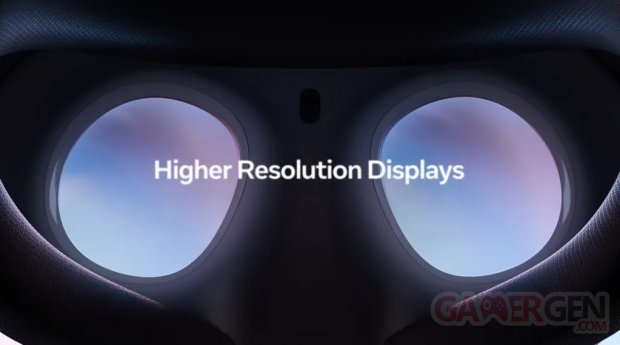Meta Quest 3 arrives with new capabilities and increased performance. Thanks to his Snapdragon XR2-Gen2announced as almost twice as efficient by Meta, we have the right to expect more in terms of display finesse. Let’s take stock, because there are things to qualify.
You will probably have all noticed that our standalone games are generally quite blurry and lack sharpness, which is why we recommend the QuestGamesOptimizer application. However, without this wonderful tool, there is a glaring observation: current games do not honor the full potential of the panels of our autonomous headsets. One of the main reasons is the lack of performance. Basically, it’s like we’re playing our Pico and Meta Quest games at 720p on a 1080p screen. It’s not embarrassing for everyone, but it’s a fact. Without much surprise, Meta Quest 3 will offer higher rendering resolution than previous iterations. This is not big news here, because it is the same with each new headset, thanks to the performance gain of the new chips.
Here is a summary table of the number of pixels per screen of our current headsets versus the rendering resolution used by default.
| Pixels per eye/screen | Default rendering resolution | |
| Meta Quest 1 | 1440x1600px | 1216x1344px |
| Meta Quest 2 | 1832x1920px | 1440x1584px |
| Meta Quest Pro | 1800x1920px | 1440x1584px |
| Meta Quest 3 | 2064x2208px | 1680x1760px |
| pico 4 | 2160x2160px | 1440x1584px |
It is obvious that after reading the table, we can affirm that the screens are not used to their fair value and the image is therefore blurry. We can therefore assume that the Quest 3, like the possible next Pico 5, will suffer from this same problem. Indeed, let us not forget that autonomous virtual reality headsets embed mobile chips which we ask to process many more pixels than on a simple PC screen. The resolutions expected to exploit screens are getting closer to, or even exceeding, 4K if we combine the sum of the pixels of the screens. A mobile processor quickly lags behind in displaying so many pixels with a refresh rate of at least 72Hz-90Hz, or 72-90 constant frames per second. We are far from a PC need for 1080p at 60fps.
The additional power of Meta Quest 3 will therefore make it possible to run all existing content and games with a base rendering resolution of 1680x1760px. This value, like those in the table, represents a coefficient of x1.0 defined by the manufacturer. Developers, as on previous machines, will be able to apply a positive or negative multiplier to this resolution (eg: x0.8, x1.5). This is what is happening now. Some games are rendered in a resolution lower than the base resolution (ex: Hellsweeper, Hubris, Red Matter 2), when some exceptions are rendered in a higher resolution, like Walkabout Mini Golf. Compromises are often made to allow more information to be displayed on the screen without dropping performance.
Games running on the Meta Quest 3 will therefore see an automatic increase in sharpness of around an additional 16%, without any action from the developers. But this increase remains minimal, and that is why the QuestGamesOptimizer could do wonders on this new machine to really go further. Let’s bet that the vast majority of games optimized by QGO allow you to exceed the 1680x1760px threshold. So understand here that your Meta Quest 2 now runs games in a better resolution than that of the Quest 3 thanks to QGO. Now imagine the combination of the two!

Finally, let us recall that to fully exploit the capabilities of the Snapdragon XR2-Gen2developers will have to roll up their sleeves to integrate more advanced lighting effects, dynamic shadows, more detailed textures or even increase the resolution themselves by exploiting, for example, the Dynamic Resolution Scaling. Some studios have already tackled this.
THE Meta Quest 3 can be pre-ordered on Amazon at the price of €549.99 for the 128 GB version and €699.99 for the 512 GB, with Asgard’s Wrath 2 Free.
